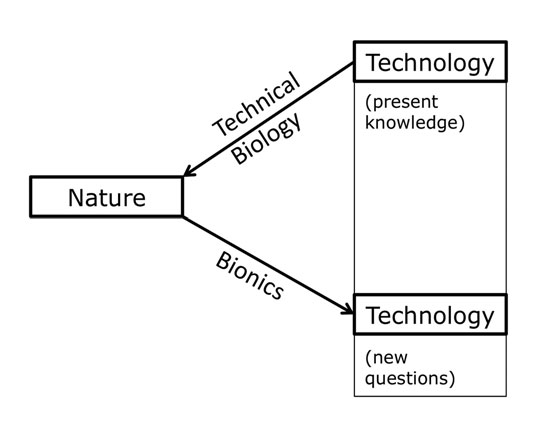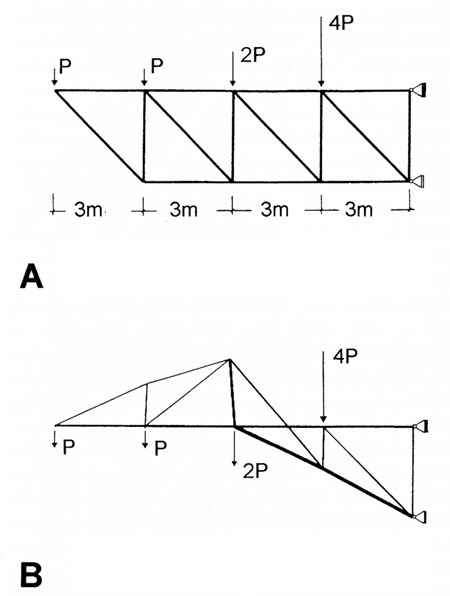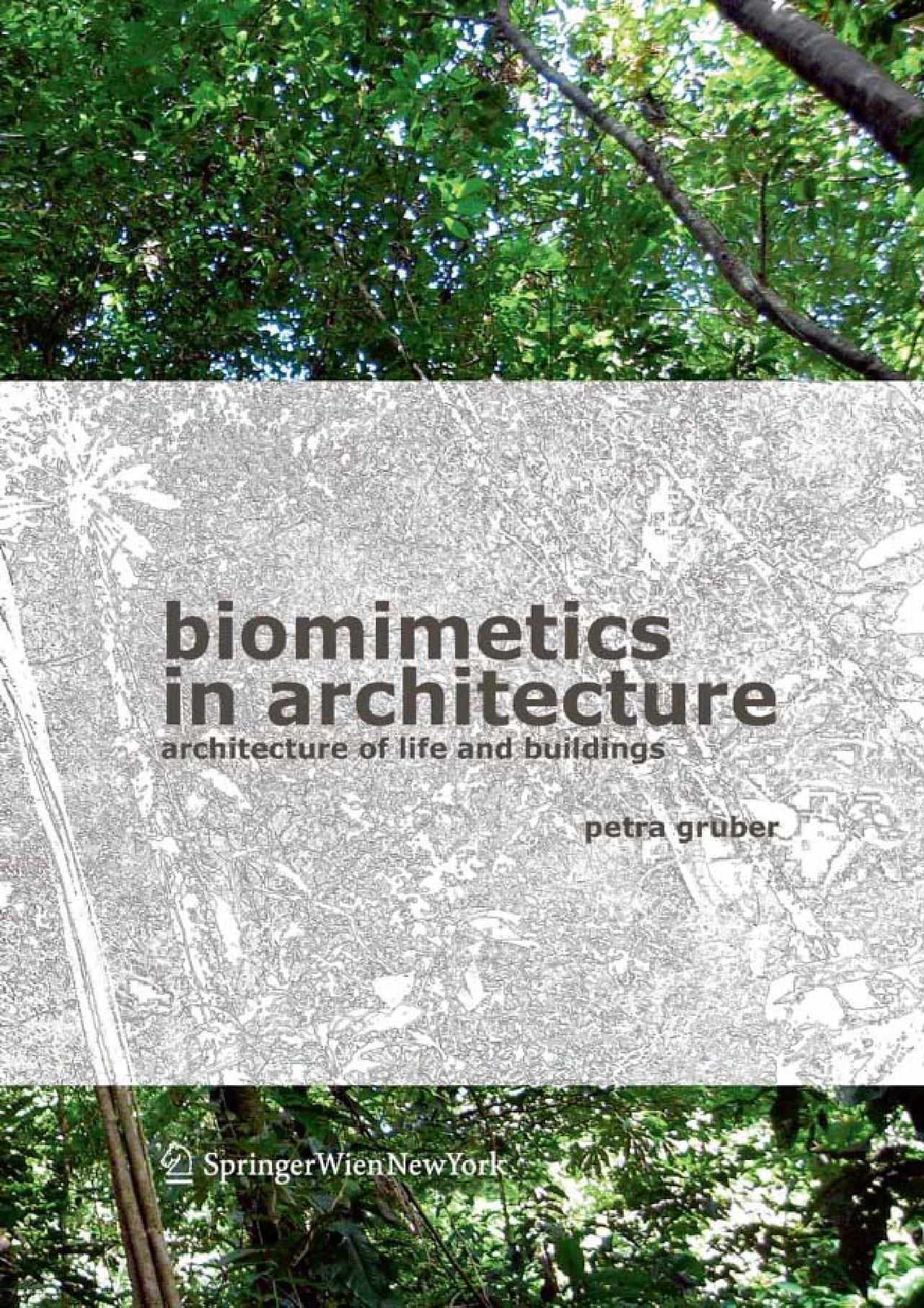2.2 BIONICS [BIONIK] BIOMIMETICS
2.2.1 Terms, definitions and related fields
The terms bionics, bionik and biomimetics
According to Werner Nachtigall, the German-language term Bionik originally comes from the
English word “bionics”, which was coined by the US Air Force Major J.E. Steele at a conference entitled “Bionics Symposium: Living prototypes – the key to new technology” in 1960, supposedly as a combination of the words “biology” and “technics” or “electronics”.
In German, the term “Bionik” has found a very expressive reinterpretation in the first and last syllables of the words Biologie [biology] and Technik [technology].
The term bionics [Bionik]: a combination of two terms: biology, the science of life.
technology, the constructive creation of products, devices and processes by using the materials and forces of nature, taking into account the laws of nature.

The term “bionics” nowadays has a narrow definition: robotics and replacement or enhancement of living matter, tissue, body parts and organs with mechanical versions. In the English-speaking world, the term “biomimetics” has appeared as equivalent to the German “Bionik” and is commonly used. Otto Schmidt coined this term in the 1950s.
As the part “mimetic” suggests a mimicking of nature, the term is controversial. Recently, “Bioinspiration” has been used more often in the same context, but seems to be too general to prevail.
Another solution for the continuing terminology discussion is to also use the term “bionik” in English.
In the following, the three terms bionics, bionik and biomimetics will be used synonymously.
Interpretation
“Technical biology means ‘understanding nature with the help of technology’. Bionics means ‘learning from nature for the sake of technology’.
Neither perspective is trivial. They consciously transcend the disciplinary boundaries and do not involve the exclusion or rejection of knowledge.
They hold the merging of biology and technology to be essential, but are conscious of their respective methodological peculiarities and of the limits on an integrated view.
Technical biology is devoted to uncovering a small sector of the realm of the unknown. This is an independent civilizational and cultural task, like all basic scientific research.
Bionics takes the results and renders them useful. This is a practical necessity of our times.”
Quoting Max Planck: “Application must be preceded by knowledge”; Werner Nachtigall presents the disciplines of Bionik and Technical Biology as antipodes:
“Technical biology… examines and describes constructions and processes of nature in light of the analyses and descriptive methods of physics and technology… is basic research, a task of civilization and culture…
Bionics… combs the thicket of nature’s constructions and processes in search of inspiration for independent technological creation… is a practical necessity”
Both disciplines complement each other in the cycle of continuing scientific technical development and progress.
The following definition of the term “bionik” was agreed in 1993 at a meeting of The Association of German Engineers (VDI), and extended by Werner Nachtigall in 1998:
“As a scientific discipline, bionics deals systematically with the technical execution and implementation of constructions, processes and developmental principles of biological systems. This also includes various forms of interaction between living and non-living elements and systems.”
Less complicated definitions are also used in Germany and the UK for communicating what the young discipline is about. On the website of the German Biokon network, Bionik is defined as “Decoding of ‘inventions of animate nature’ and their innovative implementation in technology” and the Centre for Biomimetics at the University of Reading defines Biomimetics simply as “the abstraction of good design from nature.” Bionik and biomimetics both are defined as activities, taking information from the field of biology (or nature in general) to technology.
Function, form and structure
Transfers from living nature make sense because natural models have come into being through the process of evolution, subjected to many and various conditions. They therefore represent extremely complex solutions, and their translation is not merely a matter of form.
Frei Otto wrote about natural and technical constructions:
“Constructions possess a shape or (geometrical) form and an inner structure. Form and structure come into being by way of a common developmental process, depending on physical and chemical laws or human creative power.”
Juri Lebedew stated, “In nature, the principle of integration of function+form+structure is effective, and is adapted to the existence and interrelation with the environment.”
The existing object always embodies both process and result. The integrity of form, structure and function in nature makes purely morphological translations worthless.
Optimisation
“It is said again and again that nature ‘optimizes’ everything, and bionics is on a constant search for specific optima. The concept of ‘optimum’ in nature and how it may resemble – or differ from – the same concept in business and technology is a subject of fundamental inquiry.”
The statement of Werner Nachtigall introduces the discussion about the fundamental differences between otpimisation in nature and in technological environments.
“In both of these fields, optima can usually be arrived at via mathematical optimisation computations… In biology, the complexity of the influencing factors and optimisation criteria is usually too great to formulate a definite objective function.”
In contrast to biology, optimisation of technological structures can be carried out, nowadays also with help of design tools based on evolutionary strategy, as is presented in the example of the optimisation of a cantilevering framed truss.

Fig.4 Optimisation of a framed structure: A Nonoptimised
framed structure – initial form, B Final form,
optimised for defined conditions.
The expressions “nature designs” and “nature optimises” personalise nature, but nature possesses neither a creative mind nor the ability to perform creation, and nature has no interest.
“…Evolution is as value-free as the dance of Shiva, where all beauty and ugliness, creation and destruction are expressed or compressed into one complex symmetrical pathway…
The fascinating cases of adaptation that make nature appear so clever, so ingenious, may also be early steps toward pathology and overspecialisation.”
The natural processes that lead to this apparent perfection will be described later.
In fact time-variable environmental conditions, animate and inanimate, mainly trigger the optimisation development of organisms. The frame of reference, which is important for the existence and survival of specific organisms, is not known in detail. Statements about optimisation with regard to specific conditions are assumptions, which often
enough prove to be right, but optimisation in an absolute sense does not exist.
In technology the framing for optimisation processes is also very specific and the outcome highly dependent on the starting design. Any mistake in the framing or a bad starting design renders the optimisation process worthless.
This is valid also for architecture: setting the right frame for a decision is perhaps one of the most important tasks in design.
Moreover, the environmental conditions in nature are changing continuously. Therefore adaptation is an ongoing process, on ontogenetic as well as phylogenetic level.
Optimisation in nature is transient, depending on dynamic circumstances, which are changing in space and time.
Overview of subfields
The field of bionics is so young that the establishment of more specific subfields is nowhere near being concluded. The following more detailed classification offers a cursory survey of the current state of research, and can by no means be regarded as complete.
All examples that can be found for bionics can be allocated to three broad, general subfields, which are according to Nachtigall further differentiated into subfields.
Structural bionics
Nature’s constructions, structures, materials
Procedural bionics
Nature’s procedures or processes
Informational bionics
Principles of development, evolution and information transfer
Detailed subfields
“Structures bionics [Strukturbionik] (material bionics)
Biological structural elements, materials and surfaces.
Device bionics
Development of usable overall constructions.
Structural bionics [Konstruktionsbionik]
Biological constructions, closely related to above structural and device bionics.
Anthropobionics (bionic robotics, bionic prosthetics)
Issues of human/machine interaction, ergonomics.
Construction bionics [Baubionik]
Light constructions occurring in nature, cable constructions, membranes and shells, transformable constructions, leaf overlays, use of surfaces, etc.
Climate bionics (energy bionics) Passive ventilation concepts, cooling and heating.
Sensory bionics
Detection and processing of physical and chemical stimulation, location and orientation within an environment.
Locomotion bionics (bionic kinematics and dynamics) Walking, swimming and flying as primary forms of movement. Interaction with the surrounding medium.
Neurobionics
Data analysis and information processing.
Evolutionary bionics
Evolution techniques and evolution strategies, made useful for technology.
Process bionics
Photosynthesis, hydrogen technology, recycling.
Organizational bionics
Complex relationships of biological systems”
The distinction between the subfields suggested by Nachtigall seems to be academic, but is still the most comprehensive effort to order the field.
As different categories are used, many examples can be allocated to more than one subfield. The subfields represent merely different emphases, but the differentiation implies that the field of bionics will be increasingly important. In some disciplines bionic approaches are already integrated in industry.
Some of the subfields are especially interesting for architecture: structural, climate, construction, locomotion and evolutionary bionics are promising
fields.
For architecture as a whole, the expressions of “biomimetics in architecture” or “Architekturbionik” includes and transcends what Nachtigall calls “Construction bionics” [Baubionik].
